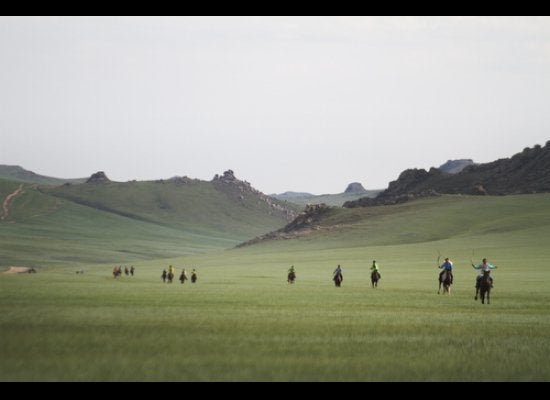It's a warm July afternoon in Ugtaal County in central Mongolia, and a crowd gathers on the open steppe under a rickety bandstand. I'm here with the Vanishing Cultures Project and videographer Lauren Knapp to document the traditions of Mongolian nomadic herders. In our efforts to research the effects of globalization on this traditional culture, we've found ourselves here this afternoon to record one of Mongolia's centuries-old surviving traditions.
As a Mongolian flag flaps lazily in the breeze, men on horseback and women bouncing babies in their arms gather on either side of a grassy causeway created by two lines stretched between wooden stakes. Suddenly, dark dots appear on the horizon, rapidly cresting the hill one after the other. The crowd's excited chatter rises by a few decibels, and as the dots come closer, their shapes become distinguishable against the electric green of the valley -- they are horses, and this is Ugtaal County's race of stallions. The crowd at the finish line begins to cheer the winners home.
Horse racing is part of the trifecta of "manly sports" that make up Mongolia's annual Naadam, a nationwide sports festival that is seeing a recent resurgence in popularity. The "three manly sports" of horse racing, wrestling, and archery are all ancient military arts that have been practiced for centuries as a requisite part of Mongolian warrior culture. Today, these sports are celebrated during Naadam -- named after the verb naada, "to play" -- as cornerstones of Mongolian heritage.
Like Ugtaal, every county and province hosts its own Naadam in early July to select finalists to compete at the national Naadam, which takes place on July 11-13 each year in Mongolia's capital, Ulaanbaatar. As a national holiday, shops close, workers head home, and people refer to it as the best time of the year.
"The three manly sports are a source of pride for Mongolians because they're such old traditions, and they've been happening for so many centuries," says Battulga, the mayor of Ugtaal. "Everyone waits the whole year to see these sports, and once Naadam is over, people start waiting eagerly for next year's Naadam."
The tradition of Naadam can be traced back to the 13th century, when Chinggis Khan threw them as celebrations of successful military campaigns. Returning warriors marked their victory by drinking, eating, wrestling, and showing off their manly skills. Eventually, this also became a way to train young men in the military arts. Centuries later, after Mongolia's socialist revolution of 1921, Naadam became institutionalized as the official celebration of the people's army, and it took on the organized form of competition that is seen at modern Naadams today.
"I have always participated in Naadam, every year," says Gantumur, a lifelong resident of Ugtaal. "There was a time when not many people participated in Naadam. But now it's getting better, more people are becoming involved."
Mongolia is experiencing a cultural revival: while an economy estimated by the International Monetary Fund to be the fourth-fastest growing in the world launches Mongolia onto the world stage, feelings of nationalism are driving people to reclaim a Mongolian heritage and identity that were actively effaced during the Soviet Era of the 20th century. And Naadam, as a direct line to Mongolia's rich cultural past, is a natural choice for a celebration and show of cultural pride.
Each of Naadam's three manly sports is steeped in historic tradition. Wrestlers wear an age-old costume of leather boots, open-front jacket, and briefs, all embroidered with traditional patterns. Archers compete in silk and brocade deels, the traditional Mongolian robe. As is the ancient practice, Mongolian horse races require child jockeys, and before each race children aged seven to twelve gather on horseback to sing the Giigoo, a folksong of praise, to their horses to urge them to do well.
But amidst the throwbacks to ancient culture, signs of modernization dot the holiday landscape both locally and nationally. Food trucks set up shop around the Naadam stadiums, selling Coca-Cola, plastic toys, and ice cream bars to the revelers. Teenagers on horseback chat on cell phones, and mothers in traditional deels strut by on spiked heels. All across the countryside, harbingers of an economy growing at break-neck speed make their appearance in Western commodities, fashions, technologies, and tastes. But as Mongolia ushers in this new market-economy culture, perhaps the traditions of the past will continue to inspire pride in the generations to come.
See more video on the manly sports at the Vanishing Cultures Project.
All images courtesy of Taylor Weidman/Vanishing Cultures Project.
